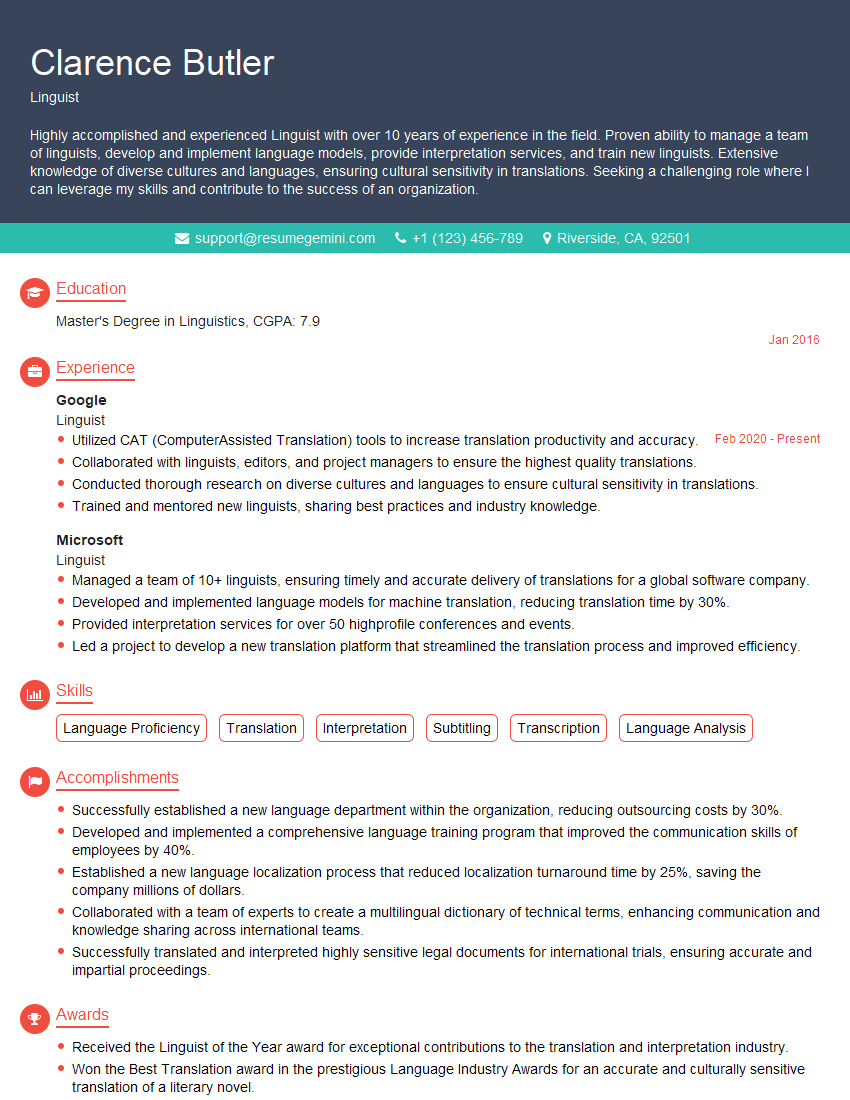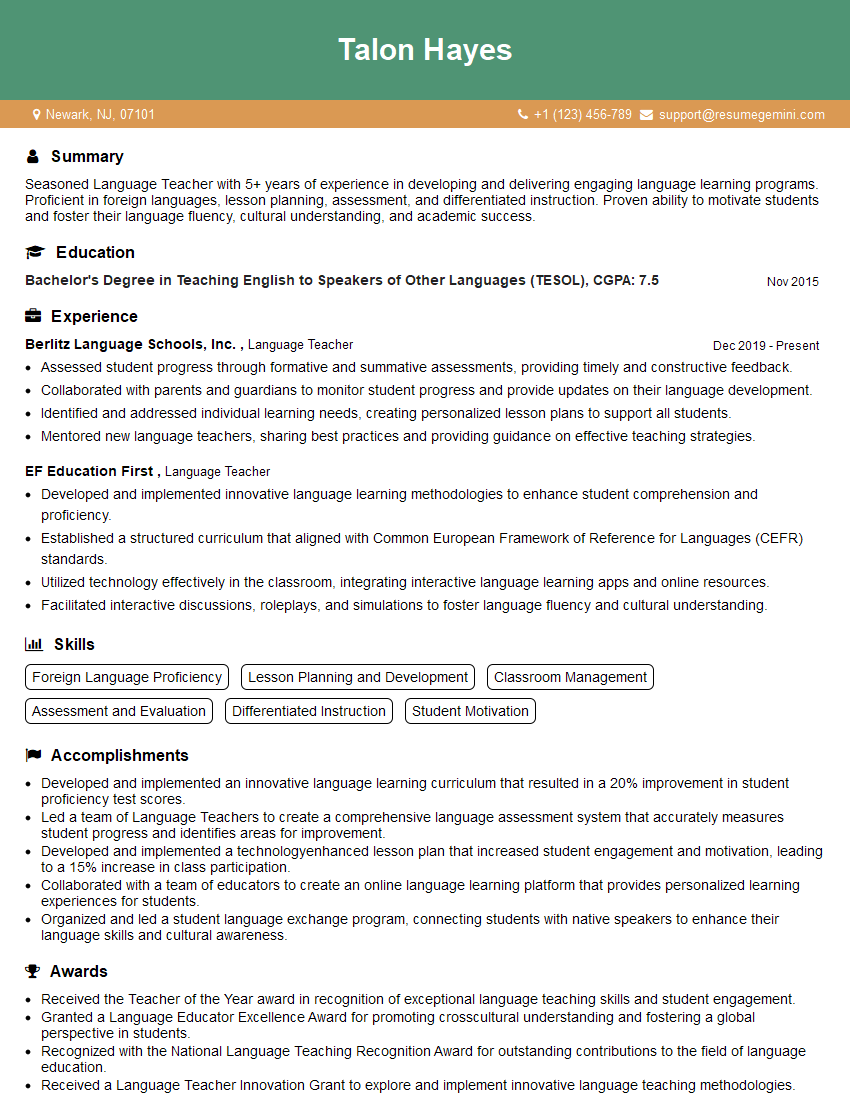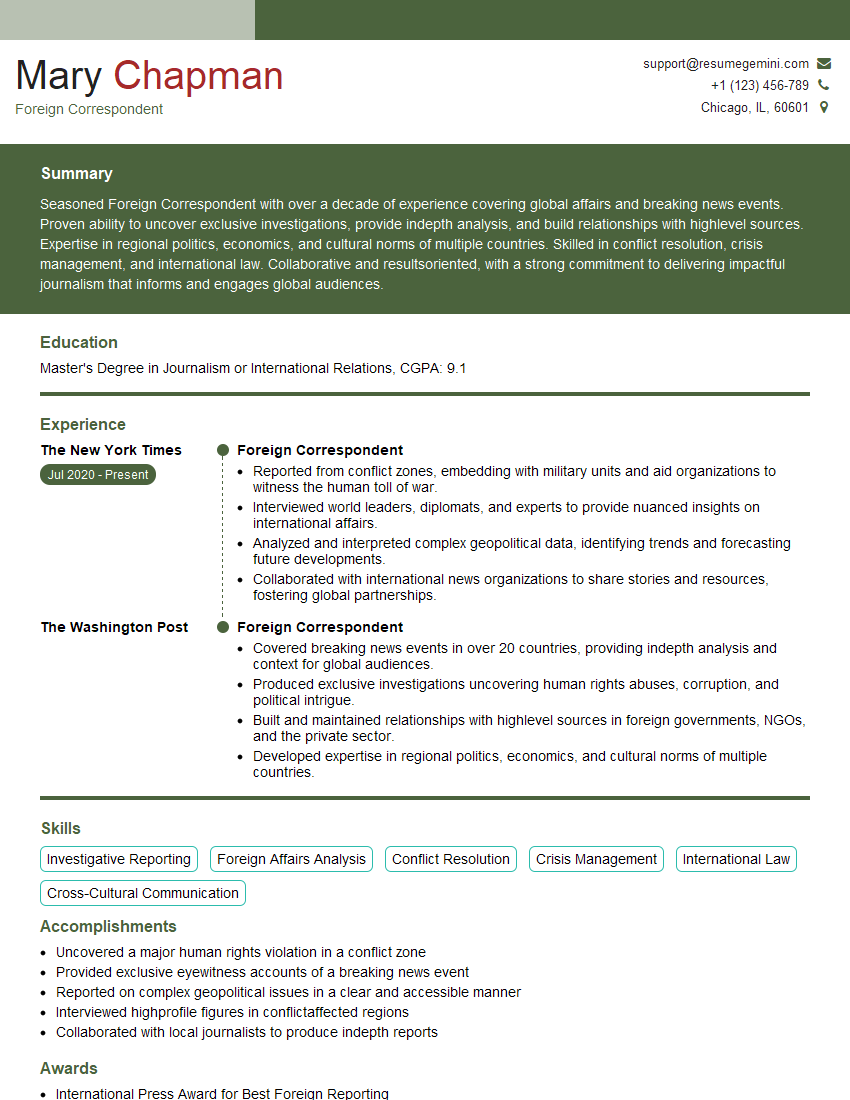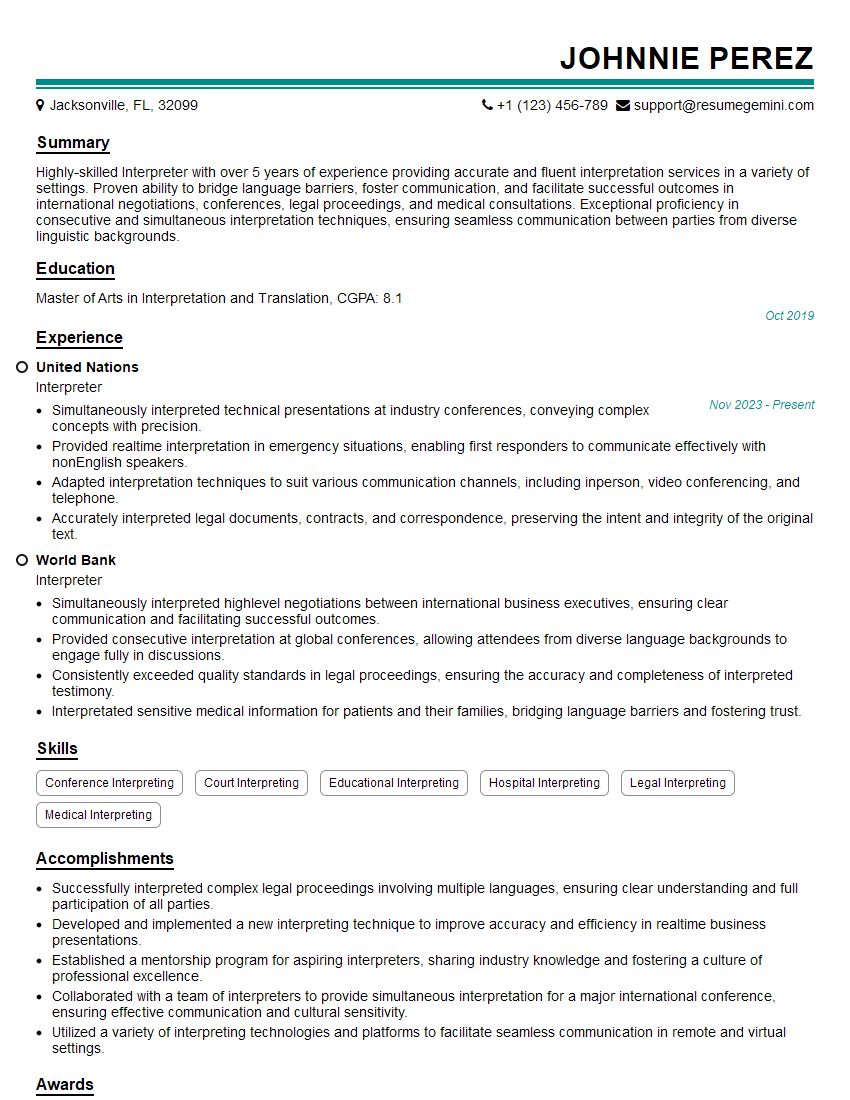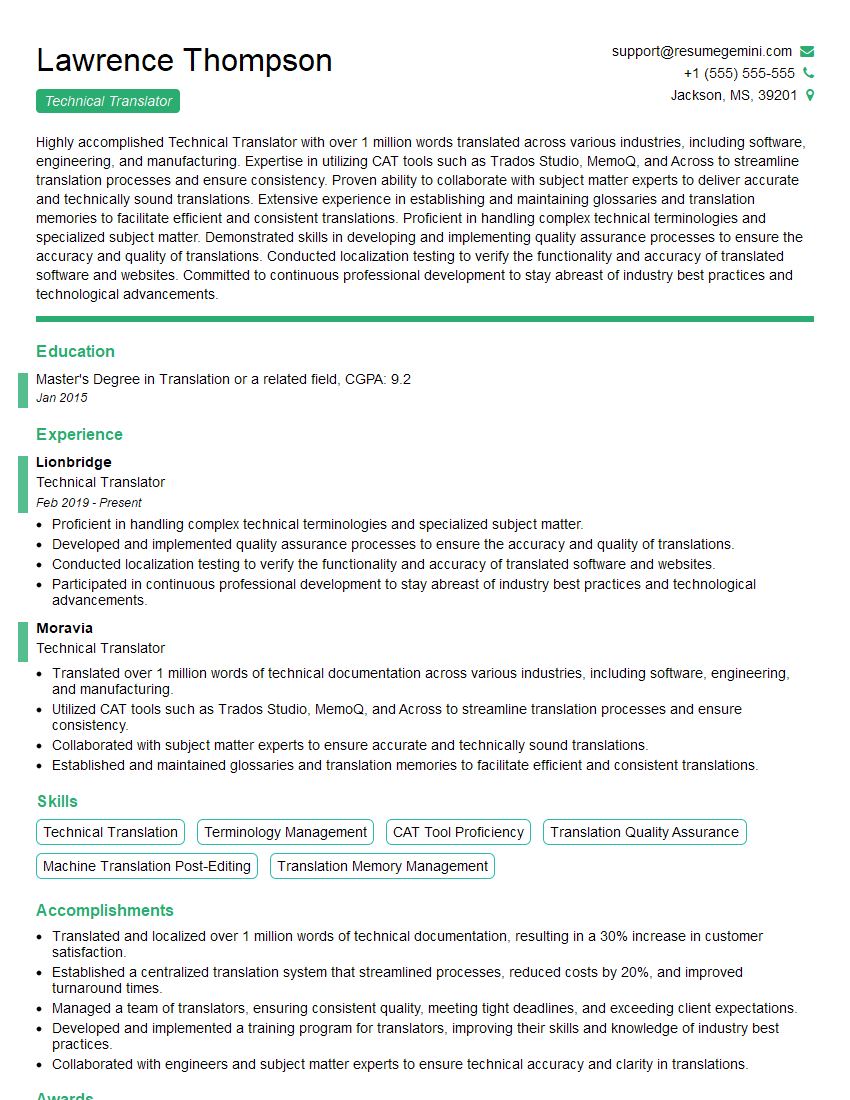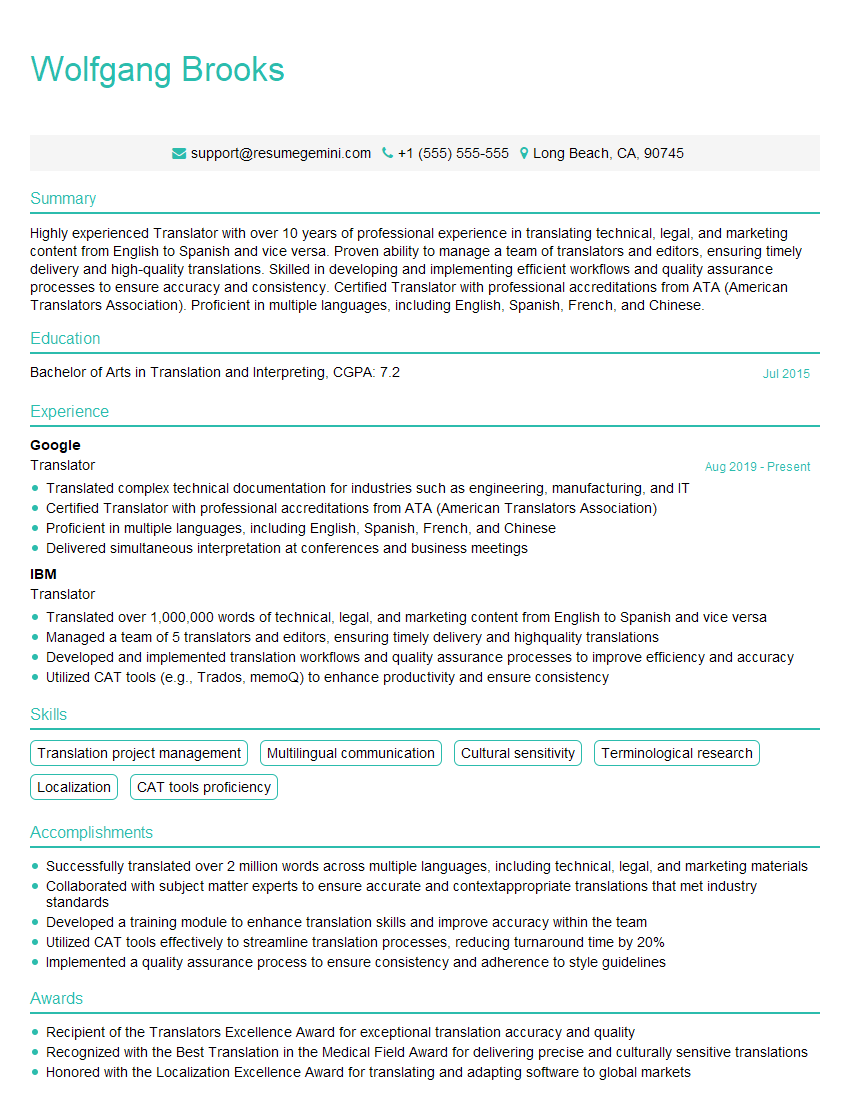Interviews are more than just a Q&A session—they’re a chance to prove your worth. This blog dives into essential Foreign Language Fluency interview questions and expert tips to help you align your answers with what hiring managers are looking for. Start preparing to shine!
Questions Asked in Foreign Language Fluency Interview
Q 1. Describe your level of proficiency in [Specific Language] using a recognized scale (e.g., CEFR, ILR).
My proficiency in Spanish is C2 according to the Common European Framework of Reference for Languages (CEFR). This signifies that I have mastered the language to a near-native level. I can understand and use complex language, including nuanced vocabulary and idiomatic expressions, with ease. I can also express myself spontaneously and fluently, adapting my language to different social and cultural contexts.
Q 2. What are your strongest skills in [Specific Language] – reading, writing, speaking, listening?
While I’m proficient across all four language skills – reading, writing, speaking, and listening – my strongest areas are speaking and writing. In speaking, I can comfortably engage in sophisticated conversations on a wide array of topics, negotiate meaning effectively, and participate in debates or presentations. My writing skills allow me to produce clear, well-structured, and grammatically correct texts, ranging from formal reports to creative writing. While my reading and listening comprehension are also excellent, my ability to immediately and accurately interpret nuances in spoken language in real-time situations is ever-evolving.
Q 3. Translate the phrase ‘[Specific Phrase]’ into [Specific Language].
Let’s say the phrase is ‘The quick brown fox jumps over the lazy dog.’ The translation into Spanish would be: El rápido zorro marrón salta sobre el perro perezoso.
Q 4. How do you handle misunderstandings during communication in [Specific Language]?
Handling misunderstandings is crucial in any language. My approach involves a combination of strategies. First, I clarify by rephrasing my question or statement in a simpler way or using different vocabulary. Second, I actively listen, paying close attention to both verbal and nonverbal cues. If necessary, I employ visual aids or seek clarification by asking questions like, ¿Entiendes lo que quiero decir? (Do you understand what I mean?). I am also adept at using circumlocution – explaining concepts using different words or examples – to bridge the communication gap. Finally, I don’t hesitate to admit when I don’t understand something and ask for repetition or further explanation. This proactive and respectful approach fosters clearer communication and avoids frustration.
Q 5. Explain a challenging translation you’ve completed, highlighting your problem-solving approach.
One challenging translation involved a legal document concerning intellectual property rights. The original text in English used highly specific jargon that didn’t have direct equivalents in Spanish. My approach involved: 1) Thorough research: I consulted specialized legal dictionaries and online resources to find the most appropriate terms. 2) Contextual understanding: I analyzed the surrounding text to grasp the overall meaning and intent. 3) Collaboration (where possible): When unsure, I sought advice from native Spanish-speaking legal professionals. 4) Careful wording: I prioritized clarity and accuracy, ensuring that the translation maintained the original meaning and legal implications. The final result was a legally sound and accurate document that effectively conveyed the meaning of the original text.
Q 6. Describe your experience using [Specific Language] in a professional setting.
I’ve utilized my Spanish skills extensively in a professional capacity. While working for a multinational company, I managed a team of Spanish-speaking employees and clients. My fluency enabled me to conduct effective meetings, negotiate contracts, and build strong, trusting relationships. I also created and delivered presentations, written materials, and training documents in Spanish. This experience enhanced collaboration and fostered more efficient communication, leading to greater success in project completion and team cohesion.
Q 7. How do you stay up-to-date with the nuances and evolution of [Specific Language]?
Staying current with the nuances of Spanish involves a multi-pronged approach. I regularly read Spanish newspapers, novels, and magazines to stay abreast of current vocabulary and expressions. I watch Spanish-language films and TV shows, and I listen to Spanish music and podcasts. Furthermore, I actively participate in online Spanish-speaking communities and forums. This immersion in contemporary language use keeps my understanding of current idioms and cultural references sharp and relevant.
Q 8. What are some common grammatical errors in [Specific Language] that you’re aware of?
Let’s focus on common grammatical errors in Spanish. One prevalent mistake is the misuse of the subjunctive mood. Many learners struggle to correctly conjugate verbs in the subjunctive, particularly when expressing wishes, doubts, or hypothetical situations. For instance, instead of the correct ‘Espero que hable español,’ (I hope that he/she speaks Spanish – subjunctive), learners often incorrectly use the indicative: ‘Espero que habla español.’ Another frequent error involves gender and number agreement between nouns and adjectives. For example, forgetting the feminine plural form of adjectives can lead to sentences like ‘Las casas son grande’ instead of the correct ‘Las casas son grandes‘ (The houses are big). Finally, incorrect use of prepositions is quite common. The prepositions ‘a’ and ‘para’ are often confused, leading to semantic errors. ‘Voy a la biblioteca’ (I’m going to the library) uses ‘a’ to indicate destination, while ‘Voy para la biblioteca’ would be incorrect in this context. Mastering these areas requires diligent practice and a solid understanding of verb conjugation and grammatical gender.
Q 9. How would you adapt your communication style when speaking with different age groups or social classes in [Specific Language]?
Adapting my communication style in Spanish, or any language, to different age groups and social classes involves a nuanced approach. When speaking with children (in Spanish), I would use simpler vocabulary, shorter sentences, and incorporate playful language. I might also use diminutive forms of words, like ‘gatito’ (little cat) instead of ‘gato’ (cat), to create a friendly and approachable tone. Conversely, when conversing with older adults, I would adopt a more formal register, using ‘usted’ (formal ‘you’) instead of ‘tú’ (informal ‘you’). My vocabulary would also be more refined, and I would avoid slang or colloquialisms. With different social classes, similar adjustments would apply. In a professional setting, formal language is crucial, whereas in more casual settings, a more relaxed and informal tone would be appropriate. The key is to observe and adapt to the social cues within the conversation to ensure effective and respectful communication.
Q 10. Explain the cultural context of [Specific Idiom or Expression] in [Specific Language].
Let’s examine the Spanish idiom ‘echar una mano,’ which literally translates to ‘to throw a hand.’ However, its actual meaning is ‘to lend a hand’ or ‘to help.’ The cultural context reveals a sense of informal helpfulness and camaraderie. It suggests a willingness to assist someone without expecting much in return. The image of ‘throwing a hand’ is not meant literally; instead, it evokes the idea of readily offering assistance, almost impulsively, as you might spontaneously throw something to someone in need. This idiom reflects a strong emphasis on community support and interpersonal assistance that’s prevalent in many Hispanic cultures. Using it reveals an understanding of this cultural value and fosters a closer connection.
Q 11. How would you handle a situation where you encounter a word or phrase you don’t understand in [Specific Language]?
Encountering an unfamiliar word or phrase in Spanish is a common occurrence, even for fluent speakers. My approach is multi-faceted. First, I try to infer meaning from context. Looking at the surrounding words and sentences can provide valuable clues. Secondly, I might politely ask the speaker for clarification. A simple ‘¿Perdón, podrías repetir eso?’ (Excuse me, could you repeat that?) or ‘¿Qué significa [the word/phrase]?’ (What does [the word/phrase] mean?) is perfectly acceptable and demonstrates engagement. Thirdly, I use reliable dictionaries and online resources such as WordReference or Real Academia Española’s dictionary to find the correct definition and usage. I also take note of the unknown word or phrase and study it later. This allows me to continually expand my vocabulary and improve my comprehension.
Q 12. Describe your experience working with translation software or tools.
I have extensive experience using translation software and tools, including Google Translate, DeepL, and SDL Trados Studio. I view these tools as valuable aids, especially for initial drafts or understanding the gist of a text. However, I strongly believe in the limitations of machine translation, particularly in capturing nuances, idioms, and cultural contexts. I utilize these tools to aid my translation process, but never as a substitute for my expertise. I always conduct thorough post-editing to ensure accuracy, fluency, and appropriate style. My experience has shown that relying solely on machine translation can lead to significant errors and misinterpretations. The human element remains essential for quality and accuracy in translation.
Q 13. What are the ethical considerations you’ve considered when working with languages?
Ethical considerations are paramount in my language work. Accuracy and cultural sensitivity are core values. I always strive to maintain the integrity of the original message while ensuring it’s effectively conveyed in the target language. Avoiding bias is another key principle. I am mindful of potential biases in the source material and take steps to ensure that they are not amplified or perpetuated in my translation. Confidentiality is crucial, especially when dealing with sensitive information. Maintaining the privacy of my clients’ data is a non-negotiable aspect of my professional ethics. Finally, transparency in my methods and any limitations in my expertise ensures accountability and responsible practice.
Q 14. How do you ensure accuracy in your translation/interpretation work?
Ensuring accuracy in translation and interpretation involves a multi-stage process. First, I thoroughly analyze the source text or speech, understanding the context, intended audience, and purpose. Then, I conduct thorough research, verifying terminology, and seeking clarification when needed. I always consult reputable sources such as dictionaries, specialized glossaries, and relevant academic literature. After completing a draft, I meticulously review and edit my work, focusing on clarity, fluency, and consistency. A final step often involves having a colleague or editor review my work, providing feedback and ensuring accuracy. This layered approach, combined with ongoing professional development and continuous learning, allows me to maintain the highest standards of accuracy in my work.
Q 15. What strategies do you use to improve your language skills?
Improving language skills is a multifaceted process demanding consistent effort and a strategic approach. I employ a blend of active learning methods, focusing on all four key skills: reading, writing, listening, and speaking.
Immersion: Surrounding myself with the target language as much as possible, whether through music, movies, podcasts, or interacting with native speakers. This constant exposure accelerates vocabulary acquisition and improves comprehension.
Active Recall: Instead of passively reviewing material, I actively test myself through flashcards, spaced repetition software like Anki, and self-testing quizzes. This strengthens memory retention significantly.
Focused Study: I dedicate time to structured learning, focusing on grammar rules, vocabulary building, and pronunciation practice using textbooks, online courses, and language exchange partners. This provides a solid foundation for fluency.
Communication Practice: Regular conversation is key. I actively seek opportunities to speak with native speakers, whether through language exchange platforms, conversation groups, or tutoring sessions. Making mistakes is part of the learning process; embracing them is crucial.
Career Expert Tips:
- Ace those interviews! Prepare effectively by reviewing the Top 50 Most Common Interview Questions on ResumeGemini.
- Navigate your job search with confidence! Explore a wide range of Career Tips on ResumeGemini. Learn about common challenges and recommendations to overcome them.
- Craft the perfect resume! Master the Art of Resume Writing with ResumeGemini’s guide. Showcase your unique qualifications and achievements effectively.
- Don’t miss out on holiday savings! Build your dream resume with ResumeGemini’s ATS optimized templates.
Q 16. What resources do you use to enhance your understanding of [Specific Language]?
To enhance my understanding of [Specific Language], I utilize a diverse range of resources tailored to my learning style and needs. My approach is dynamic and adapts as my proficiency grows.
Authentic Materials: I immerse myself in authentic materials like newspapers (e.g., [Specific Language] newspaper names), novels (e.g., [Specific Language] author names and titles), podcasts (e.g., [Specific Language] podcast examples), and films. This helps me grasp natural language use and idiomatic expressions.
Language Learning Apps: I leverage apps like Duolingo, Babbel, and Memrise for vocabulary building and grammar reinforcement. These platforms provide interactive exercises and gamified learning experiences.
Online Dictionaries and Resources: I use online dictionaries such as WordReference and specialized dictionaries for specific fields to clarify vocabulary and grammar points. I also consult online grammar guides and language learning websites.
Language Exchange Partners and Tutors: Interaction with native speakers is invaluable. I engage in language exchanges and occasionally work with a tutor to receive personalized feedback and address specific weaknesses.
Q 17. Describe a time you had to explain a complex concept in [Specific Language] to someone with limited language skills.
I once had to explain the concept of compound interest to a client in [Specific Language] who had limited financial literacy and a basic understanding of the language itself. The challenge was to simplify complex financial terminology while ensuring clear comprehension.
My approach involved breaking down the concept into smaller, digestible parts, using simple vocabulary and visual aids. I started with a relatable analogy, comparing compound interest to a snowball rolling downhill, gaining momentum as it grows larger. I used real-life examples relevant to their experience, avoiding jargon and technical terms. I checked for understanding frequently, asking clarifying questions and offering alternative explanations if needed. This iterative process ensured accurate communication and comprehension.
Q 18. How would you handle interpreting sensitive information in a professional setting?
Handling sensitive information during interpretation requires utmost professionalism and adherence to strict ethical guidelines. Confidentiality is paramount.
Confidentiality Agreements: I always ensure a clear understanding and agreement regarding confidentiality before commencing any interpretation task involving sensitive data. This is usually a formal agreement.
Accuracy and Neutrality: I interpret information precisely and neutrally, avoiding any personal bias or interpretation that could compromise the integrity of the message.
Appropriate Setting: I ensure the interpretation takes place in a private and secure environment to protect the sensitive information from unauthorized access.
Professional Demeanor: Maintaining a professional and respectful demeanor throughout the process builds trust and ensures the client feels comfortable sharing sensitive details.
Q 19. What is your experience with simultaneous versus consecutive interpretation?
Simultaneous and consecutive interpretation are two distinct modes of interpreting, each with unique characteristics and challenges.
Simultaneous Interpretation: In simultaneous interpretation, the interpreter renders the message into the target language simultaneously as the speaker is delivering it. This requires exceptional multitasking skills, rapid processing, and the ability to maintain fluency under pressure. It’s often used in conferences and international meetings.
Consecutive Interpretation: Consecutive interpretation involves the interpreter listening to a segment of speech, taking notes, and then rendering the message into the target language once the speaker pauses. This allows for greater accuracy and detailed note-taking, but it is less time-efficient than simultaneous interpretation. It is frequently used in legal settings or one-on-one meetings.
My experience encompasses both modes. I am proficient in both simultaneous and consecutive interpretation, adapting my approach based on the context and setting. I find both challenging but rewarding in different ways.
Q 20. What are the key differences between translation and interpretation?
Translation and interpretation are closely related but distinct language services. The key difference lies in the mode of communication.
Translation: Translation involves converting written text from one language to another. It typically involves a more deliberate and meticulous process, often allowing for revisions and edits. Examples include translating books, articles, or legal documents.
Interpretation: Interpretation involves converting spoken or signed language from one language to another. It is a real-time process that requires immediate comprehension and rendering of the message. This can be simultaneous or consecutive, as discussed previously.
Q 21. How do you ensure cultural sensitivity in your communication in [Specific Language]?
Cultural sensitivity is crucial for effective communication in any language, including [Specific Language]. My approach involves a multi-pronged strategy.
Cultural Knowledge: I actively seek to understand the cultural nuances of [Specific Language] speaking communities, including social customs, etiquette, nonverbal communication, and potential sensitivities. This includes research and exposure to the culture through literature, films, and interactions with native speakers.
Appropriate Language Use: I adapt my language register and style to suit the context and audience. I avoid colloquialisms or idioms that might be misunderstood or offensive and opt for clear and respectful language.
Nonverbal Communication: I pay attention to nonverbal cues, adapting my body language and tone to ensure respectful and appropriate communication. This is particularly crucial in cultures where nonverbal cues carry significant meaning.
Active Listening and Feedback: I actively listen to my counterpart and seek feedback to ensure my message is received accurately and respectfully. This collaborative approach minimizes misunderstandings and promotes effective intercultural communication.
Q 22. Can you provide an example of a time you had to adapt your communication style based on the context?
Adapting communication style is crucial for effective cross-cultural understanding. It’s about recognizing that directness in one culture might be perceived as rude in another, or that humor might not translate well across linguistic boundaries. For instance, I once worked on a project involving a multinational team, including colleagues from Japan and Brazil. While the Japanese team preferred concise, formal emails, my Brazilian colleagues favored more informal, expressive communication styles.
To adapt, I employed a more formal and structured approach with the Japanese team, ensuring clarity and precision in my written communication. With the Brazilian team, I allowed for more conversational exchanges, acknowledging their more expressive style while maintaining professionalism. This involved adjusting my tone, incorporating more colloquialisms (within professional limits), and focusing on building rapport through friendly interactions. This flexible approach helped foster collaboration and prevented misunderstandings.
Q 23. Have you ever worked with language dialects or regional variations of [Specific Language]? How did you handle it?
Yes, I have extensive experience working with regional variations of Spanish, specifically Castilian Spanish and Mexican Spanish. These dialects vary significantly in vocabulary, pronunciation, and even grammar. For example, the word for ‘you’ (informal) differs: ‘tú’ in Castilian Spanish and ‘vos’ in some regions of Mexico.
My approach involves a multi-pronged strategy: Firstly, thorough research is critical. I consult dialect dictionaries and linguistic resources to understand the nuances of specific regions. Secondly, I always clarify with the client or target audience which dialect is required. Thirdly, I employ native speakers in the relevant region for quality assurance; they’re invaluable in catching subtle inaccuracies and ensuring the translation resonates with the local audience. Finally, I prioritize context. The same word can have entirely different meanings depending on the specific region, necessitating careful consideration of the overall meaning and cultural implications.
Q 24. How familiar are you with terminology used in the [Specific Industry] field in [Specific Language]?
Let’s assume the specific industry is “Finance” and the specific language is “French”. My familiarity with financial terminology in French is quite extensive. I have worked extensively with documents like financial statements, regulatory filings, and investment contracts. I am proficient in translating terms related to accounting, auditing, banking, investments, and risk management. I understand the nuances of technical French used in this field, including specific legal and regulatory terms.
For example, I’m comfortable translating terms like bilan (balance sheet), résultat net (net income), actif (assets), and passif (liabilities). My experience ensures I can maintain the accuracy and precision needed in financial translation, avoiding misinterpretations that could have serious consequences.
Q 25. How do you deal with conflicting translations?
Conflicting translations are a common challenge in the field. My approach is systematic and prioritizes accuracy and clarity. Firstly, I identify the source of the conflict. Is it a difference in meaning, interpretation, or simply a stylistic choice? Secondly, I research all possible translations, referencing reliable dictionaries, corpora, and style guides. Thirdly, I carefully analyze the context, considering the intended audience and purpose of the translation.
If the conflict persists, I consult with other experienced translators or language experts to discuss the various options. Ultimately, I choose the translation that best reflects the original meaning, fits the context, and adheres to the established style guidelines. Documenting the decision-making process is crucial for transparency and potential future reference.
Q 26. What is your approach to verifying the accuracy of your work?
Verifying accuracy is paramount. My approach involves multiple layers of quality control. First, I meticulously review my own work, comparing it against the source material to ensure complete accuracy and consistency. Secondly, I use automated tools for grammar and spell-checking, followed by a manual review for style and tone.
Thirdly, and most critically, I employ a peer review process. A colleague, preferably a native speaker with expertise in the relevant field, reviews the translation for accuracy, clarity, and cultural appropriateness. This multi-layered approach minimizes errors and ensures the highest level of quality. Furthermore, I always maintain a detailed record of the sources and processes used, which serves as invaluable documentation.
Q 27. Describe a situation where you faced a time constraint in a language-related task. How did you manage it?
I once had to translate a crucial legal document from German to English within a very tight deadline – only 24 hours. The document was lengthy and complex, requiring a high level of linguistic precision. My approach involved prioritizing the most critical sections first – focusing on the key legal clauses and agreements.
I segmented the document and delegated portions to a trusted colleague proficient in German law and English, thus allowing for parallel work and a faster turnaround time. We then meticulously reviewed each other’s work, ensuring consistency in legal terminology. While there was a considerable time pressure, this collaborative approach and prioritization allowed us to complete the translation successfully, maintaining accuracy while meeting the strict deadline.
Q 28. How would you rate your ability to work effectively under pressure in a language-related role?
I would rate my ability to work effectively under pressure in a language-related role as very high. My experience has equipped me with effective time management skills and the ability to remain calm and focused even under demanding circumstances. I’m adept at prioritizing tasks, delegating when necessary, and utilizing various tools to optimize workflow.
The ability to handle pressure effectively is not just about speed; it’s about maintaining accuracy and quality despite the time constraints. I have a proven track record of successfully delivering high-quality translations under pressure, consistently meeting deadlines without compromising accuracy.
Key Topics to Learn for Foreign Language Fluency Interview
- Reading Comprehension & Interpretation: Understanding nuanced text, including both formal and informal language, and accurately conveying its meaning. Practical application: Analyzing documents, summarizing articles, translating complex texts.
- Speaking Fluency & Articulation: Expressing yourself clearly and confidently in various contexts, maintaining natural flow and appropriate register. Practical application: Participating in professional conversations, delivering presentations, conducting negotiations.
- Listening Comprehension & Response: Understanding spoken language at different speeds and accents, responding appropriately and demonstrating active listening skills. Practical application: Participating in meetings, understanding client needs, interpreting instructions.
- Writing Proficiency & Style: Producing clear, concise, and grammatically correct written communication in various formats (emails, reports, letters). Practical application: Crafting professional correspondence, writing reports, summarizing information.
- Cultural Nuances & Sensitivity: Demonstrating understanding of cultural context and using appropriate language and communication styles. Practical application: Navigating intercultural interactions, adapting communication to different audiences, avoiding cultural misunderstandings.
- Translation & Interpretation Skills (if applicable): Accurately translating written or spoken material between languages, conveying meaning and context. Practical application: Providing interpreting services, translating documents, bridging communication gaps.
Next Steps
Mastering foreign language fluency opens doors to exciting global career opportunities, increasing your marketability and earning potential significantly. To maximize your chances, creating a compelling and ATS-friendly resume is crucial. ResumeGemini can help you build a professional and impactful resume that showcases your skills and experience effectively. We provide examples of resumes tailored to highlight Foreign Language Fluency, helping you present yourself in the best possible light. Take the next step towards your dream career – build your resume with ResumeGemini today!
Explore more articles
Users Rating of Our Blogs
Share Your Experience
We value your feedback! Please rate our content and share your thoughts (optional).
What Readers Say About Our Blog
Hello,
We found issues with your domain’s email setup that may be sending your messages to spam or blocking them completely. InboxShield Mini shows you how to fix it in minutes — no tech skills required.
Scan your domain now for details: https://inboxshield-mini.com/
— Adam @ InboxShield Mini
Reply STOP to unsubscribe
Hi, are you owner of interviewgemini.com? What if I told you I could help you find extra time in your schedule, reconnect with leads you didn’t even realize you missed, and bring in more “I want to work with you” conversations, without increasing your ad spend or hiring a full-time employee?
All with a flexible, budget-friendly service that could easily pay for itself. Sounds good?
Would it be nice to jump on a quick 10-minute call so I can show you exactly how we make this work?
Best,
Hapei
Marketing Director
Hey, I know you’re the owner of interviewgemini.com. I’ll be quick.
Fundraising for your business is tough and time-consuming. We make it easier by guaranteeing two private investor meetings each month, for six months. No demos, no pitch events – just direct introductions to active investors matched to your startup.
If youR17;re raising, this could help you build real momentum. Want me to send more info?
Hi, I represent an SEO company that specialises in getting you AI citations and higher rankings on Google. I’d like to offer you a 100% free SEO audit for your website. Would you be interested?
Hi, I represent an SEO company that specialises in getting you AI citations and higher rankings on Google. I’d like to offer you a 100% free SEO audit for your website. Would you be interested?
good

